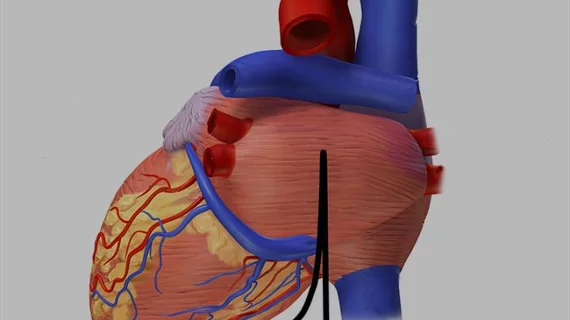Sacubitril-valsartan therapy was associated with greater reductions in N-terminal pro-B-type natriuretic peptide (NT-proBNP) than enalapril among patients hospitalized with acute decompensated heart failure, according to research presented Nov. 11 at the American Heart Association’s Scientific Sessions and published online simultaneously in the New England Journal of Medicine.
Patients treated with the angiotensin receptor–neprilysin inhibitor combination also had fewer rehospitalizations for heart failure (8.0 percent versus 13.8 percent) and a trend toward lower rates of death at eight weeks (2.3 percent versus 3.4 percent), but those endpoints were exploratory and not the focus of the study.
PIONEER-HF included 881 patients from 129 sites across the U.S. randomized 1:1 to the two treatment arms. Patients were tritrated to a target dose of 97 mg of sacubitril with 103 mg of valsartan twice daily or 10 mg of enalapril twice daily. All participants had left ventricular ejection fraction of 40 percent or less and elevations in either NT-proBNP or B-type natriuretic peptide, had received a primary diagnosis of acute decompensated heart failure and met criteria for being hemodynamically stable before randomization.
Researchers led by Eric J. Velazquez, MD, said it was important to study this patient population because the previous PARADIGM-HF trial demonstrated the efficacy of sacubitril-valsartan in an ambulatory, outpatient setting, leaving the benefits unknown for inpatients with acute decompensated HF.
But PIONEER-HF found the sacubitril-valsartan combination was associated with a 46.7 percent reduction in NT-proBNP concentrations eight weeks after randomization, compared to a 25.3 percent NT-proBNP reduction with enalapril. The relative reduction for sacubitril-valsartan versus enalapril was 29 percent at eight weeks and 24 percent after week one.
At baseline, the median NT-proBNP concentration was 4,812 pg/mL.
“The beneficial effect of sacubitril–valsartan on the concentration of NT-proBNP, which is a biomarker of neurohormonal activation, hemodynamic stress, and subsequent cardiovascular events, was accompanied by a reduction in the concentration of high-sensitivity cardiac troponin T, which is a biomarker of myocardial injury associated with abnormalities of cardiac structure and function and with a worse prognosis among patients with heart failure,” wrote Velazquez, with Yale University School of Medicine, and colleagues.
“The results of the PIONEER-HF trial extend the evidence base regarding the use of sacubitril–valsartan to populations for which there had been limited or no data, including patients who are hospitalized for acute decompensated heart failure, patients who have new heart failure, patients who have not been exposed to high doses of guideline-directed medications for heart failure, and patients who are not receiving conventional renin–angiotensin system inhibitors.”
Larry Allen, MD, with University of Colorado Hospital in Aurora, predicted the benefit seen across additional patient groups will simplify medication decisions and meaningfully change clinical practice.
“This is a simpler algorithm for inpatient and subsequent outpatient management of patients with heart failure with reduced ejection fraction (HFrEF),” Allen said. “This is better for people like me who manage these patients, and it’s better for the patients themselves who don’t have to switch and make a bunch of changes, so let’s keep it simple. It reinforces the importance and safety of aggressive guideline-directed medical therapy, which is where we can make huge strides in the care of these patients.”
Allen said data from the CHAMP registry, which includes ambulatory U.S. patients with HFrEF, indicate that only 15 percent of eligible patients are being prescribed sacubitril-valsartan despite a Class I recommendation from the American Heart Association. He also acknowledged the medications in both groups in PIONEER-HF were prescribed at higher doses than what is typically seen in routine clinical practice.
“We’ve done OK at least in the U.S. at initiating these drugs but intensifying them to a maximal dose or at least 50 percent of the dose that was targeted in trials has been an area of quality of care for these patients that has been less well-achieved. … There’s gaps in terms of using and uptitrating the ACE (angiotensin converting enzyme) inhibitors and then there’s a bigger gap in terms of transitioning those patients over to sacubitril-valsartan which is a Class I recommendation,” Allen said.
However, Allen hopes this study will help overcome the “clinical inertia” involved in current prescribing practices and push the management of these patients “closer to what we would say is the optimal medical therapy.”
Don Lloyd-Jones, MD, professor of preventive medicine at Northwestern University, reiterated that the NT-proBNP biomarker was the primary endpoint, so more work must be done to clarify potential event reductions associated with sacubitril-valsartan in this setting.
“The clinical endpoints here are extremely promising-looking, but … they’re depending on a small number of events so there could be some chance at play here, perhaps not in the overall effect but in the signs of that effect,” Jones said. “So, I think we’re going to want to see potentially larger trials to nail down exactly what the signs of the effect (are) and that will be certainly helpful to try to help the guideline writers decide just how hard to push on this potentially promising new therapy.”
Velazquez et al. noted they used a 36-hour washout period to ensure that patients previously taking an ACE inhibitor or angiotensin II receptor blocker (ARB) didn’t have any overlapping medications. Even with that precaution, each treatment group had about a 20 percent discontinuation rate by eight weeks, primarily due to adverse events.
“Taken together, these considerations suggest that the initiation of any neurohormonal agent in this population should be performed cautiously,” the authors wrote.
The trial was funded by Novartis, which sells sacubitril-valsartan under the brand name Entresto.

